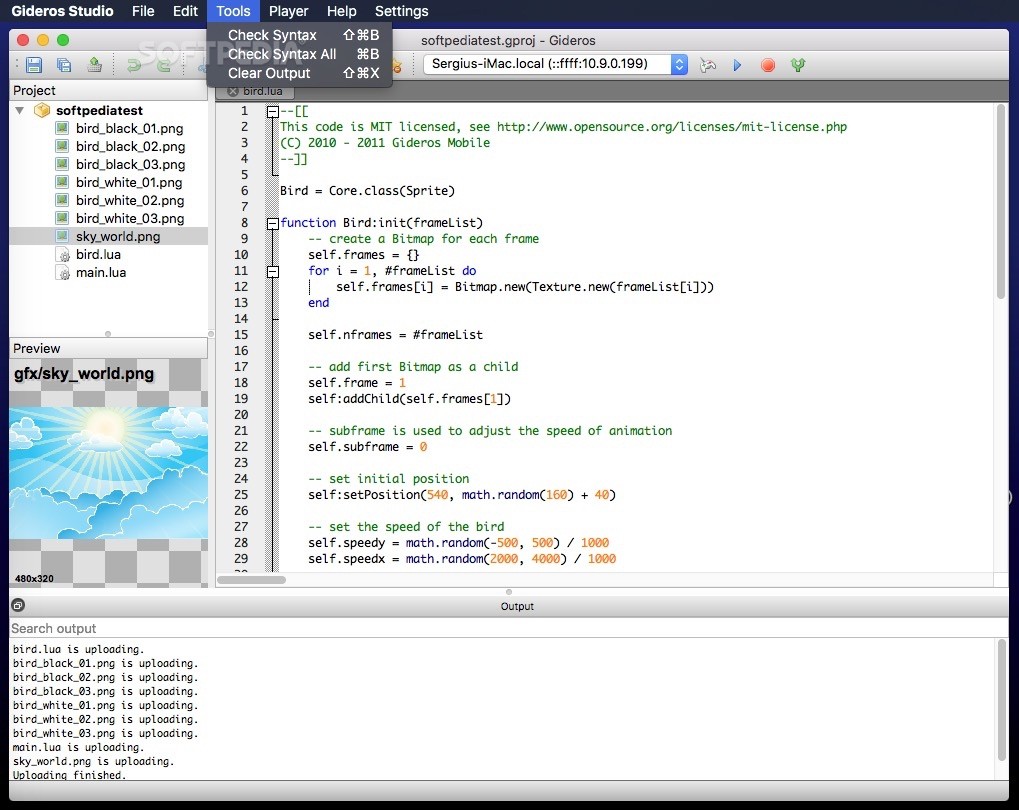
- #Gideros basics full#
- #Gideros basics code#
- #Gideros basics mac#
When the desktop theme is set to dark mode, some of the panels in RUBE (eg. Without this setting the program will run, but the help documentation and action menu will not be present. You can set this in the 'Workspace' tab of the Options dialog (aka 'Preferences' on macOS). The directory should be the location of the rubehelp_en.* files and the 'config' folder that contains To work around this RUBE requires that you manually set the working directory you wish to use. This has dubious actual value but is quite successfulĪt making life difficult for thousands of users and developers all over the world.
In recent versions of macOS Apple introduced a 'security feature' called translocation that preventsĪpplications from knowing the location (working directory) they are running from. Some points to note when running on macOS: #Gideros basics mac#
Almost identical across Windows, Mac and Linux (some shortcut keys differ on Mac).Build-on-demand executable file requires no further DRM.Integrated feedback/bug-report dialog with screenshot capability.Dialog to check for updates and view release notes.
 General log output to report warnings, errors and tips. Context help panel (content changes depending on current editor state). Integrated help browser for script API and general help.
General log output to report warnings, errors and tips. Context help panel (content changes depending on current editor state). Integrated help browser for script API and general help. #Gideros basics code#
Dump C++ code (Box2D's standard feature).Items can be excluded from export by customizable script.
#Gideros basics full#
Click here to see the full script API (under 'Rubescript reference'). Scripts can be attached to event hooks (eg. Scripts can query the user for numbers and strings during execution. All actions are logged to script as autosave data. Script can access all information necessary to write custom exporters. Customizable menu for calling your scripts. getSelectedBodies) to implement contextual tasks Integrated script editor with code highlighting, auto-compile and error line-marking. Any operation possible on the scene via the GUI can be scripted. (if the item is offscreen an arrow will be shown pointing to it) Hovering the mouse over an item in the list highlights it in the scene view.  List can be filtered to quickly find items. Items expand to show their relation in a tree format (eg. Allows selection and name changing of items. Shows items in the scene in a textual list. Markers displayef for joints, body CoM etc. Items can be named for access from your program. Switch between degree or radian display for angles. Rotation and scale can be about selection center or cursor position. Translations can be restricted to x/y axes. Context menu to disambiguate items in the same location. Reference grid to help judge dimensions. Item properties display is customizable (which properties to show for currently selected items). Action menu contents can be modified to include your own scripts. Items (body, fixture, joint, image, sampler) can be given custom properties (int, float, string, vec2, bool, color). Write Sobel edge filter, local maxima edge output to file.
List can be filtered to quickly find items. Items expand to show their relation in a tree format (eg. Allows selection and name changing of items. Shows items in the scene in a textual list. Markers displayef for joints, body CoM etc. Items can be named for access from your program. Switch between degree or radian display for angles. Rotation and scale can be about selection center or cursor position. Translations can be restricted to x/y axes. Context menu to disambiguate items in the same location. Reference grid to help judge dimensions. Item properties display is customizable (which properties to show for currently selected items). Action menu contents can be modified to include your own scripts. Items (body, fixture, joint, image, sampler) can be given custom properties (int, float, string, vec2, bool, color). Write Sobel edge filter, local maxima edge output to file.  Use alpha or color edge data to automatically create fixtures. Set output file, opacity, flip, color tint. Sample multiple source images as a composition. Set opacity, filter type, flip, color tintĪ sampler defines a rectangular area from which to sample image pixels. Position images as background props or use them as guides when creating physics objects. Joints will be copied along with bodies so entire structures can be easily duplicated. Set damping and frequency (distance, wheel). Append/insert to chain (draw a sequence of points). Automatic polygon decomposition for concave polygons. One-step creation of polygon fixtures from images. Negative scale (flip fixtures across x/y axis). Negative scale (flip bodies across x/y axis). Entire structures of bodies with joints can be scaled. Here is a breakdown of some of the current features in R.U.B.E.
Use alpha or color edge data to automatically create fixtures. Set output file, opacity, flip, color tint. Sample multiple source images as a composition. Set opacity, filter type, flip, color tintĪ sampler defines a rectangular area from which to sample image pixels. Position images as background props or use them as guides when creating physics objects. Joints will be copied along with bodies so entire structures can be easily duplicated. Set damping and frequency (distance, wheel). Append/insert to chain (draw a sequence of points). Automatic polygon decomposition for concave polygons. One-step creation of polygon fixtures from images. Negative scale (flip fixtures across x/y axis). Negative scale (flip bodies across x/y axis). Entire structures of bodies with joints can be scaled. Here is a breakdown of some of the current features in R.U.B.E.







 0 kommentar(er)
0 kommentar(er)
